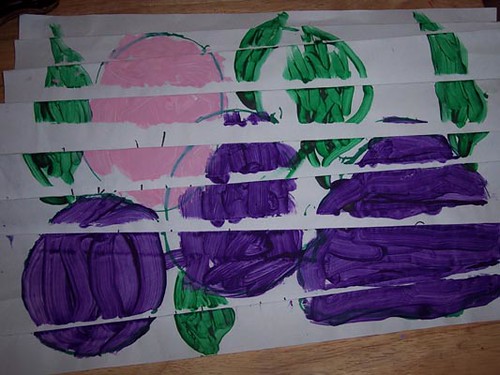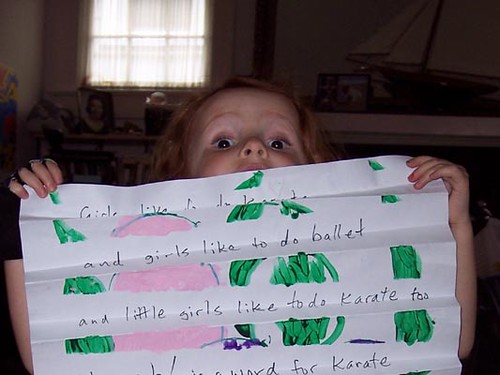Poetry is different, because its forms are so varied. There are traditional pieces that look very organized and rhyme and maybe fit on a page in a sonnety way. There are more freeform pieces with different line lengths and interesting breaks and punctuation. A child encouraged to write a poem may not immediately know the scope -- two lines, twenty lines, twenty pages? This project was a way that my kindergardener could visualize her poem and get a sense of the space she was going to fill, before she wrote it.
I found this cool painting technique on Scrumdilly-Do and decided to modify it into a poetry prompt for teaching the junior class in Phi Bensa Zoe Academy. Phillip is five, Sadie is four, and they both did really well with this.
If you click on this link for the painting idea, you'll see very excellent how-to pictures, much much better than mine. The basic idea is that you fold up a big piece of paper in a staggered accordion fold. You just put little ripples in it so that when it all lies flat there is a new surface for the paper , with lots of hidden little strips folded up into it. Then you paint on this new surface:

Then you let it dry for a while and stretch it out:

This is where the poetry comes in. After the kids had these neat staggered strips of color and these white strips in between, I had them dictate a poem to me, and I wrote each line in a white strip. Very cool. They could see how many lines they needed and about how long the lines would be, so I think it looked somehow doable for them. Anyway, they did it:

Here's Sadie with her finished project. It is a poem about ballet and karate and I think the theme of it is that she really likes to leap around the house yelling and making muscles at us but that doesn't mean she can't still call herself a ballerina.

The coolest thing about this is that you can fold the paper back up, hiding the poetry, and it becomes a painting again. It's a secret poem. Possibly a magic poem. The magical properties have not yet been tested yet. If I wake up and the sink is empty of dirty dishes, I will let you know. It certainly was cool to put it back together, and unfold it, and fold it up again, etc.
Many skills involved here: folding, paper-clipping, painting in one direction (you want to paint in strokes perpendicular to the folds so you don't get any into the white strips) Sadie enjoyed herself, and so did Phillip. So, good for kindergarten. But would this exercise have value beyond the paste-craving years? An older child, or even an adult, might find this an interesting way to integrate writing and art. The pre-defined line limit could be seen as a constraint or a challenge -- kind of like making yourself write a sestina or even a haiku. Give it a try and see what you come up with. And props to Scrumdilly-do again.
We're part of the Book Arts Bash. Are you?

Wow, Lydia, that is so cool! I plan to read some poetry with Jack this weekend and then we'll try this.
ReplyDeleteWoohoo! A way to make it visual! Thank you!